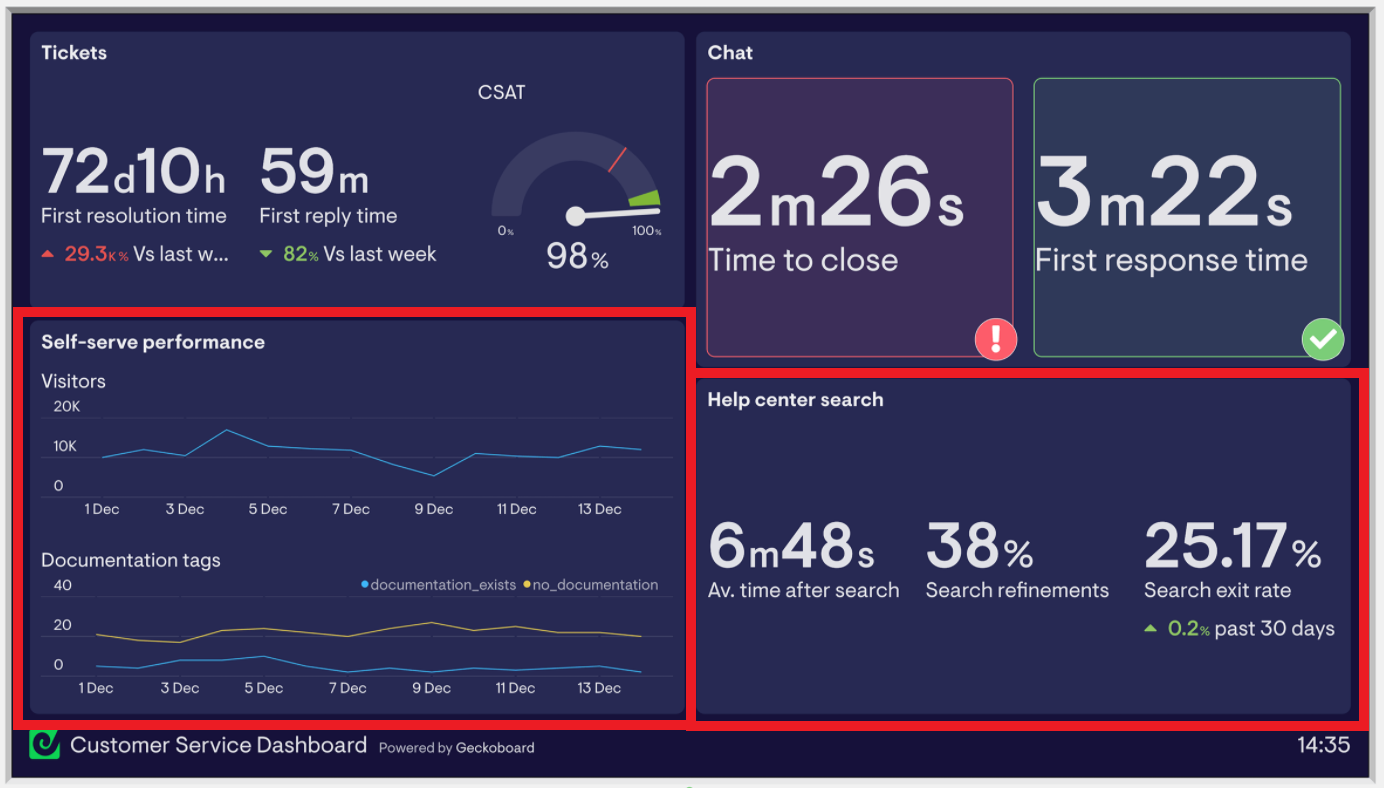Customer support KPIs (key performance indicators) allow you to understand what level of service you’re providing for your customers, including how long they have to wait and if they’re happy with the outcome of the interaction. KPIs also help you communicate your support team’s contributions to the rest of the business.
But there are many ways to measure the performance of your customer support team: response times, number of interactions, time to resolution, and much more. How do you decide what you should track, and how should you share this information with your team?
We put together a simple guide to help. Follow these tips to define customer support KPIs that help motivate your team and improve customer satisfaction.
Start with your strategy
The first step toward choosing the best customer support KPIs for your business is to look at your current customer support strategy. Until you know what your goals are, you can’t select specific indicators of your progress.
Identify your most important objectives for your support team. These are typically broad goals, like “improve customer satisfaction.”
Defining your top priorities will help you narrow down the dozens of potential metrics and choose ones that directly relate to your goals. For example, if one of your organization’s goals is to increase customer retention, you might want to focus on indicators of customer happiness, like Customer Satisfaction or Customer Effort Score.
Set measurable goals
Once you’ve defined broad goals, think about the key results that need to happen to meet these objectives. If you want to reduce time spent per support ticket, how long do reps currently spend on average?
Knowing what key results you need to achieve will tell you what KPIs to prioritize. For example, if your goal is to have customer support reps spend 30% less time resolving a ticket, then you would want to track Average Handle Time and Average Resolution Time.
When you’re first getting started, consider using industry benchmark reports to get an idea of industry-appropriate goals for your team. If you want to improve your First Response Time, you might use benchmarks to determine expected response times in your industry and set specific goals based on your findings.
Keep in mind that the most relevant information will come from companies similar to your own and that KPIs can vary based on company stage, business goals, and other factors.
Industry benchmarks are most helpful in the early stages of choosing customer support KPIs for your team. Once you’ve started collecting data for each metric, you can use your own past performance to set improvement goals rather than solely looking at performance data from other companies.
Look at the most common customer support KPIs
In customer support, there’s a standard set of metrics that most teams track. These are an excellent place to start as you nail down your strategy and priorities, and they are useful to track over the long term, too.
A few examples of these widely applicable KPIs are:
- Average Reply Time (ART): ART measures how long it takes agents to respond to a customer after the customer messages the support team. Unlike First Response Time, it doesn’t include automated messages or acknowledgments that the ticket was received, and it is not exclusively measured in business hours. ART tells you how long a customer has to wait before getting a response from a person.
- Customer Satisfaction (CSAT): CSAT indicates customer happiness with your team, product, or brand. It’s typically based on a short survey that customers complete after the support rep resolves the ticket. This survey can take several different forms, but at its most basic level, it asks customers to rate their experience on a scale ranging from good or great to bad.
- First Response Time (FRT): FRT looks at the length of time between when a customer submits a ticket and when they receive an initial response from your team. It is typically measured in business hours.
- Ticket Backlog: Ticket backlog counts how many outstanding customer support tickets your team has at a given time.
This is just a sample of the common customer support KPIs you might choose from. For more information about these and other examples, check out this resource.
Even when you track more custom metrics, these four KPIs can still help you notice problem areas. You might track First Response Time initially because it’s a common metric and then realize your team’s response times are slower than you expected. You might also notice that your efforts to improve one KPI are adversely affecting another (sometimes called the Cobra Effect).
Break down metrics by support channel
If you have several options for customers to contact you – such as live chat, email, phone, or social networks – it’s essential to track how each channel performs. With platform-specific analyses, you can more quickly identify the source of support issues and work on resolution plans.
Say you notice your CSAT declining month over month. By diving into channel-specific metrics, you see that each week, customers are much less satisfied with the quality of support they get via email than from phone or chat. Now you can start working with your team to figure out how to improve customer service via email.
Consider displaying your top-priority KPIs on a customer support dashboard so your team can reference them quickly. It’s still useful to track how your less popular support channels are doing, but you won’t need to check metrics for these as often as for high-volume ones.
Include self-service channels as you build your set of metrics. Track page views on articles to see what customers most often need help with, then see if you can address the root problem behind their search. For example, if your most-viewed page offers troubleshooting tips for a particular feature, you might work with your product team to make that feature more user-friendly so the customer doesn’t need to seek additional help to use it.

In addition, track the Ratio of Views vs. Tickets Submitted for high-traffic pages. Are customers seeking help in your knowledge base and then turning to customer support when they can’t find the answer? A low views-to-tickets ratio might indicate gaps in your knowledge base or documentation and a need to expand your self-help resources.
Review your customer support KPIs regularly
KPIs aren’t a “set it and forget it” endeavor. Businesses grow, and goals and priorities change. Consider whether you need to update your metrics on at least an annual or biannual basis.
Check in with your support team, both as a group and during one-on-one meetings, and talk to them about their individual and business goals with your team as well. Determine what types of metrics would help them measure progress toward both of these goals.
Ensure your reps know which metrics you’re prioritizing and include them in the discussion of which KPIs to keep and which to put on the back burner. Share your customer support KPIs with your team regularly, such as by displaying them on a TV dashboard or sharing them via Slack or in a daily email. Encourage reps to provide feedback on the metrics you share. If they find some data on the dashboard is no longer relevant, that’s an indicator that you need to revisit your KPIs and define new ones to align with changing goals and strategies.
Use data from customer support KPIs to inform your strategy
Think of your customer support strategy as a loop: your current strategy informs the KPIs you choose, and the data from those KPIs helps you decide how to adjust your strategy.
When metrics are performing poorly, use that information to find solutions and create an action plan. If your ticket backlog is growing instead of shrinking or remaining consistent, it could indicate you need another support team member or that your team needs more resources or training to help them handle their current ticket volume.
By the same token, KPIs that are performing well can show you parts of your strategy that are working. You can then take these successful tactics and apply them to help boost your underperforming KPIs.
After all, defining the right customer support KPIs is only useful if you’re able to act on the data and improve your customer support as a result.
Want to learn more about KPIs and how to define the right ones for your company? Check out these resources!
- A complete guide to key performance indicators: Definition, uses and examples
- The A-Z guide to startup metrics: 16 KPIs to help your business succeed
- How to choose the right sales KPIs for your team (plus 10 examples for any industry)
- 12 ecommerce KPIs you should be tracking (+ tips from ecom experts)
- Defining KPIs: How to Choose Metrics That Inspire Action


